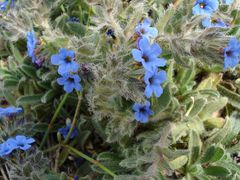Alkanna tinctoria
| Alkanna tinctoria subsp. var. | ||||||||||||||||||||||||||||||||||||||||||||||||||||||||
|---|---|---|---|---|---|---|---|---|---|---|---|---|---|---|---|---|---|---|---|---|---|---|---|---|---|---|---|---|---|---|---|---|---|---|---|---|---|---|---|---|---|---|---|---|---|---|---|---|---|---|---|---|---|---|---|---|

|
|
| ||||||||||||||||||||||||||||||||||||||||||||||||||||||
| ||||||||||||||||||||||||||||||||||||||||||||||||||||||||
The name alkanet generally refers to Alkanna tinctoria or Dyer's Bugloss (though it may be used for Anchusa officinalis or Common Bugloss).
It is a member of the Borage family Boraginaceae.
Alkanna tinctoria is also known as orchanet, dyer's bugloss, Spanish bugloss or bugloss of Languedoc. Its name comes from the Spanish word alcana, from Arabic al-hena, after henna, (Lawsonia inermis).
Alkanet is grown in the south of France and on the shores of the Levant. It has a dark red root of blackish appearance externally but inside showing a blue-red meat, surrounding a whitish core. Its root yields a fine red colouring matter which has been used as a coloring/dye.
Cultivation
Propagation
Pests and diseases
Varieties
Gallery
-
photo 1
-
photo 2
-
photo 3
References
External links
- w:Alkanna tinctoria. Some of the material on this page may be from Wikipedia, under the Creative Commons license.
- Alkanna tinctoria QR Code (Size 50, 100, 200, 500)
